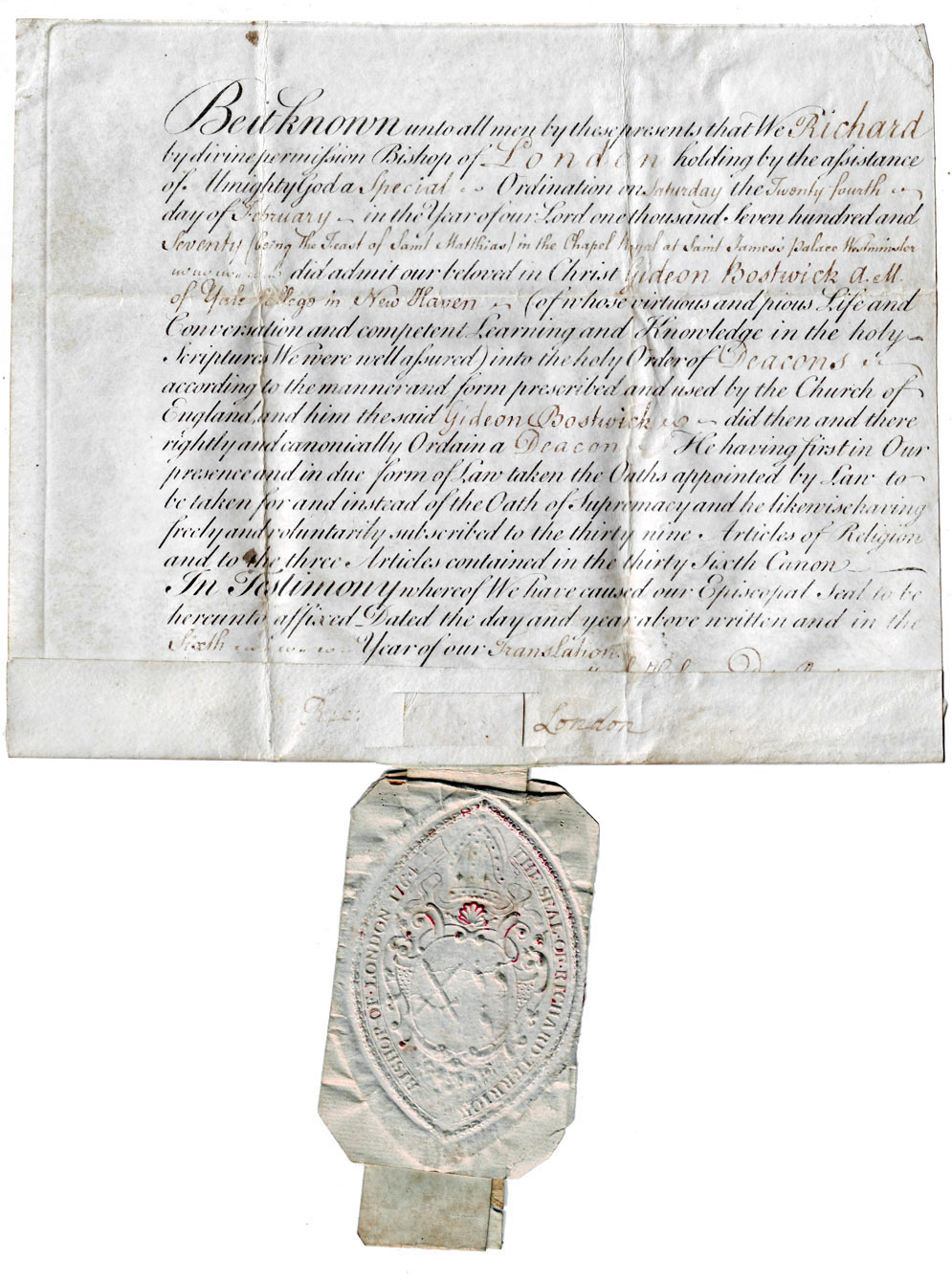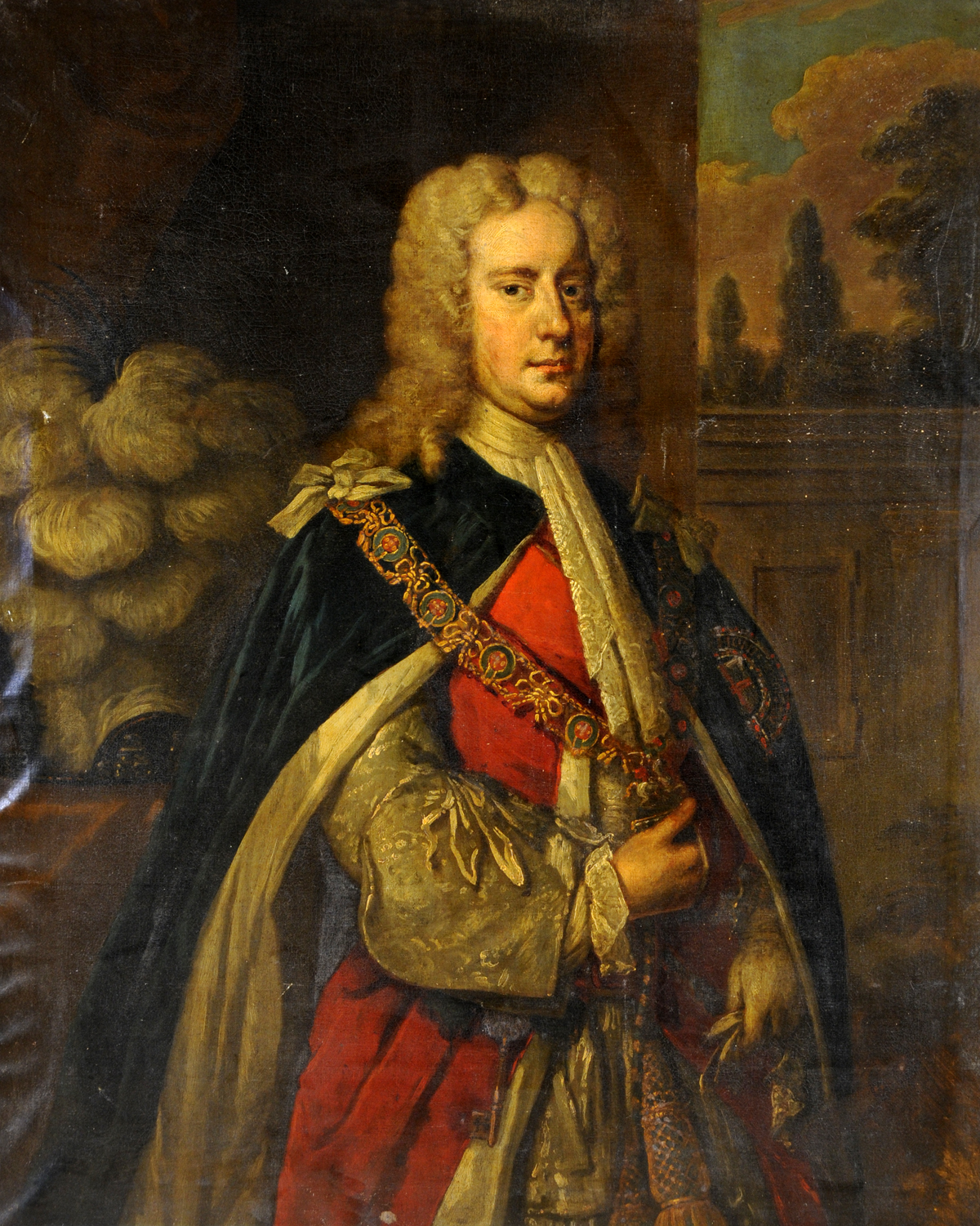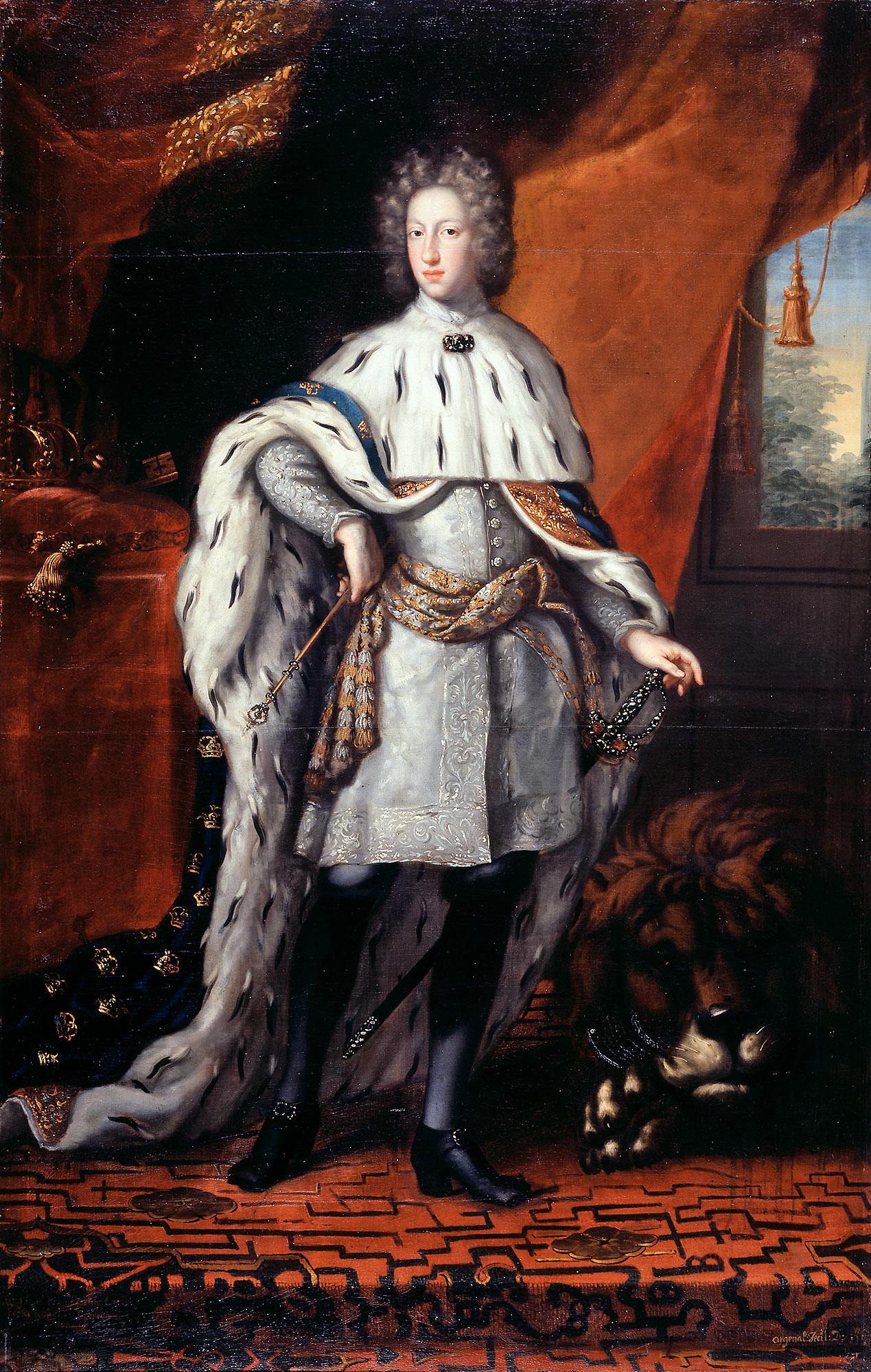|
John Robinson (1650–1723)
John Robinson (7 November 1650 – 11 April 1723) was an English diplomat and prelate. He became the Bishop of London and Dean of Windsor, succeeding to Henry Compton. Early life Robinson was born at Cleasby, North Yorkshire, near Darlington, a son of John Robinson (died 1651) a cooper by trade and Elizabeth Potter. Educated at Brasenose College, Oxford, he became a fellow of Oriel College, and in about 1680 he became chaplain to the British embassy to Stockholm. He remained in Sweden for nearly thirty years. During the absence of the minister, Philip Warwick, Robinson acted as resident and as envoy extraordinary, and he was thus in Sweden during a very interesting and important period, and was performing diplomatic duties at a time when the affairs of northern Europe were attracting an unusual amount of attention. Among his adventures, not the least noteworthy was his journey to Narva with Charles XII in 1700. Career In 1709, Robinson returned to England, and was appoin ... [...More Info...] [...Related Items...] OR: [Wikipedia] [Google] [Baidu] |
Bishop Of London
The bishop of London is the Ordinary (church officer), ordinary of the Church of England's Diocese of London in the Province of Canterbury. By custom the Bishop is also Dean of the Chapel Royal since 1723. The diocese covers of 17 boroughs of Greater London north of the Thames, River Thames (historically the City of London and the County of Middlesex) and a small part of the County of Surrey (the district of Borough of Spelthorne, Spelthorne, historically part of Middlesex). The Episcopal see, see is in the City of London, where the seat is St Paul's Cathedral, which was founded as a cathedral in 604 and was rebuilt from 1675 following the Great Fire of London (1666). Third in seniority in the Church of England after the archbishops of Archbishop of Canterbury, Canterbury and Archbishop of York, York, the bishop is one of five senior bishops who sit as of right as one of the 26 Lords Spiritual in the House of Lords (for the remaining diocesan bishops of lesser rank, seats are ... [...More Info...] [...Related Items...] OR: [Wikipedia] [Google] [Baidu] |
Darlington
Darlington is a market town in the Borough of Darlington, County Durham, England. It lies on the River Skerne, west of Middlesbrough and south of Durham. Darlington had a population of 107,800 at the 2021 Census, making it a "large town" and one of the largest settlements in North East England. The town is linked to London, Leeds, York, Newcastle and Edinburgh by the East Coast Main Line and the A1. History Darnton Darlington started as an Anglo-Saxon settlement. The name derives from the Anglo-Saxon ''Dearthington'', which seemingly meant 'the settlement of Deornoth's people' but, by Norman times, the name had changed to Derlinton. During the 17th and 18th centuries, the town was usually known by the name of ''Darnton''. Darlington has a historic market area in the town centre. St Cuthbert's Church, built in 1183, is one of the most important early English churches in the north of England and is Grade I listed. The oldest church in Darlington is St Andrew's Chur ... [...More Info...] [...Related Items...] OR: [Wikipedia] [Google] [Baidu] |
War Of The Spanish Succession
The War of the Spanish Succession was a European great power conflict fought between 1701 and 1714. The immediate cause was the death of the childless Charles II of Spain in November 1700, which led to a struggle for control of the Spanish Empire between supporters of the French House of Bourbon, Bourbons and the Austrian House of Habsburg, Habsburgs. Charles had named as his heir Philip V of Spain, Philip of Anjou, a grandson of Louis XIV of France, whose claim was backed by Kingdom of France, France and most of Habsburg Spain, Spain. His Habsburg rival, Charles VI, Holy Roman Emperor, Archduke Charles, was supported by the Grand Alliance (League of Augsburg), Grand Alliance, whose primary members included Habsburg monarchy, Austria, the Dutch Republic, and Kingdom of Great Britain, Great Britain. Significant related conflicts include the Great Northern War (1700–1721) and Queen Anne's War (1702–1713). Although by 1701 Spain was no longer the predominant European power, ... [...More Info...] [...Related Items...] OR: [Wikipedia] [Google] [Baidu] |
Treaty Of Utrecht
The Peace of Utrecht was a series of peace treaty, peace treaties signed by the belligerents in the War of the Spanish Succession, in the Dutch city of Utrecht between April 1713 and February 1715. The war involved three contenders for the vacant throne of Spain, and had involved much of Europe for over a decade. Essentially, the treaties allowed Philip V of Spain, Philip V (grandson of King Louis XIV of France) to keep the Spanish throne in return for permanently renouncing his claim to the French throne, along with other necessary guarantees that would ensure that France and Spain should not merge, thus preserving the balance of power in Europe. The treaties between several European states, including History of Spain (1700–1810), Spain, Kingdom of Great Britain, Great Britain, Kingdom of France, France, Kingdom of Portugal, Portugal, Duchy of Savoy, Savoy and the Dutch Republic, helped end the war. The treaties were concluded between the representatives of Louis XIV of Fran ... [...More Info...] [...Related Items...] OR: [Wikipedia] [Google] [Baidu] |
Runic Alphabet
Runes are the Letter (alphabet), letters in a set of related alphabets, known as runic rows, runic alphabets or futharks (also, see ''#Futharks, futhark'' vs ''#Runic alphabets, runic alphabet''), native to the Germanic peoples. Runes were primarily used to represent a sound value (a phoneme) but they were also used to represent the concepts after which they are named (ideographic runes). Runology is the academic study of the runic alphabets, runic inscriptions, runestones, and their history. Runology forms a specialised branch of Germanic philology. The earliest secure runic inscriptions date from at latest AD 150, with a possible earlier inscription dating to AD 50 and Tacitus's possible description of rune use from around AD 98. The Svingerud Runestone dates from between AD 1 and 250. Runes were generally replaced by the Latin alphabet as the cultures that had used runes underwent Christianisation, by approximately AD 700 in central Europe and 1100 in northern Europe. Ho ... [...More Info...] [...Related Items...] OR: [Wikipedia] [Google] [Baidu] |
James Stanhope, 1st Earl Stanhope
James Stanhope, 1st Earl Stanhope (1673 – 5 February 1721) was a British army officer and Whig politician who effectively served as Chief Minister between 1717 and 1721. He was also the last Chancellor of the Exchequer to sit in the House of Lords. Born in Paris as the son of a prominent diplomat, Stanhope pursued a military career. Although he also served in Flanders and Italy, he is best remembered for his service in Portugal and Spain during the War of the Spanish Succession. He was the first British Governor of Minorca, which he captured from the Spanish in 1708. In 1710 he commanded the British contingent of the Allied Army which occupied Madrid, having won a decisive victory at the Battle of Zaragoza. Having then evacuated the Spanish capital, Stanhope's rearguard on the retreat to Barcelona were overwhelmed and forced to surrender at Brihuega. Paroled, he returned to Britain and pursued a political career as a Whig. A supporter of the Hanoverian Succession he w ... [...More Info...] [...Related Items...] OR: [Wikipedia] [Google] [Baidu] |
Lord Privy Seal
The Lord Privy Seal (or, more formally, the Lord Keeper of the Privy Seal) is the fifth of the Great Officers of State (United Kingdom), Great Officers of State in the United Kingdom, ranking beneath the Lord President of the Council and above the Lord Great Chamberlain. Originally, its holder was responsible for the monarch's Privy Seal of England, personal (privy) seal (as opposed to the Great Seal of the Realm, which is in the care of the lord chancellor) until the use of such a seal became obsolete. Though one of the oldest offices in European governments, it has no particular function today because the use of a privy seal has been obsolete for centuries; it may be regarded as a traditional sinecure, but today, the holder of the office is invariably given a seat in the Cabinet of the United Kingdom, and is sometimes referred to as a Minister without portfolio (United Kingdom), minister without portfolio. Since the premiership of Clement Attlee, the position of Lord Privy S ... [...More Info...] [...Related Items...] OR: [Wikipedia] [Google] [Baidu] |
Dean Of The Chapel Royal
The Dean of the Chapel Royal, in any kingdom, can be the title of an official charged with oversight of that kingdom's chapel royal, the ecclesiastical establishment which is part of the royal household and ministers to it. England In England, the Dean of the Chapels Royal was appointed by royal warrant and appointed its officers and staff. The office of dean (dating from 1312) has been by custom held by the Bishop of London since 1748 (or 1723, see below). In practice, the chapel, its choir, and the various chapel buildings associated with it come under the oversight of the Sub-Dean, who is the King's residential chaplain. As in 2019 the Chapels Royal in England consisted of: the Chapel Royal, St James's Palace; The Queen's Chapel; the Chapel Royal, Hampton Court Palace; the Chapel of St Peter ad Vincula (Tower of London); the Chapel of St John the Evangelist (Tower of London); and The Queen's Chapel of the Savoy. Office holders ;Edward III (1327) *: John de Wodeford *: Jo ... [...More Info...] [...Related Items...] OR: [Wikipedia] [Google] [Baidu] |
Bishop Of Bristol
The Bishop of Bristol heads the Church of England Diocese of Bristol in the Province of Canterbury, in England. The present diocese covers parts of the counties of Somerset and Gloucestershire together with a small area of Wiltshire. The see is in the City of Bristol where the seat is located at Bristol Cathedral. The bishop's residence is a house in Winterbourne, Gloucestershire, north of Bristol. The bishop is Vivienne Faull (previously Dean of York), since the confirmation of her election on 25 June 2018.York Minster — Acting Dean of York (Accessed 29 June 2018) She was consecrated at on 3 July 2018 and enthr ... [...More Info...] [...Related Items...] OR: [Wikipedia] [Google] [Baidu] |
Dean Of Wolverhampton
The Dean of Wolverhampton was the head of the chapter of canons at St Peter's Collegiate Church, Wolverhampton, until the chapter was disestablished in 1846. The collegiate church was, until that point, a royal peculiar falling outside of the diocesan and provincial structures of the Church of England. Today, the church is district church within a team parish led by a rector, although it has its own vicar and curate within the team. It is now part of the Diocese of Lichfield. List of deans The deanery was probably established in the mid-12th century, along the lines adopted at Lichfield Cathedral, as the church was in episcopal hands at that time. The names of earlier heads of the chapter and any deans before Peter of Blois have not survived. Samson, William the Conqueror's chaplain was feudal overlord of the canons, but there is no evidence he headed the chapter and he was not ordained priest until he became bishop of Worcester. The following were deans of Wolverhampton before ... [...More Info...] [...Related Items...] OR: [Wikipedia] [Google] [Baidu] |
Charles XII Of Sweden
Charles XII, sometimes Carl XII () or Carolus Rex (17 June 1682 – 30 November 1718 Old Style and New Style dates, O.S.), was King of Sweden from 1697 to 1718. He belonged to the House of Palatinate-Zweibrücken, a branch line of the House of Wittelsbach. Charles was the only surviving son of Charles XI of Sweden, Charles XI and Ulrika Eleonora the Elder. He assumed power, after a seven-month caretaker government, at the age of fifteen. In 1700, a triple alliance of Denmark–Norway, Electorate of Saxony, Saxony–Polish–Lithuanian Commonwealth, Poland–Lithuania and Tsardom of Russia, Russia launched a threefold attack on the Swedish protectorate of Holstein-Gottorp and provinces of Swedish Livonia, Livonia and Swedish Ingria, Ingria, aiming to take advantage of the Swedish Empire being unaligned and ruled by a young and inexperienced king, thus initiating the Great Northern War. Leading the Swedish army against the alliance, Charles won multiple victories despite being si ... [...More Info...] [...Related Items...] OR: [Wikipedia] [Google] [Baidu] |
Battle Of Narva (1700)
The Battle of Narva (, ; ) on (20 November in the Swedish calendar, Swedish transitional calendar) was an early battle in the Great Northern War. A Sweden, Swedish relief army under Charles XII of Sweden defeated a Tsardom of Russia, Russian siege force three to four times its size. Previously, Charles XII had forced Denmark–Norway to sign the Treaty of Travendal. Narva was not followed by further advances of the Swedish army into Russia; instead, Charles XII turned southward to expel August the Strong from Livonia and Polish–Lithuanian Commonwealth, Poland–Lithuania. Tsar Peter the Great of Russia took Narva in a Battle of Narva (1704), second battle in 1704. Background During the 17th century, Tsardom of Russia, Russia was less advanced technologically than the rest of Europe, a condition which extended to its armed forces.Peter The Great – Swift Despite this shortcoming, Peter the Great of Russia was keen to get "an adequate opening to the Baltic" by conquering pa ... [...More Info...] [...Related Items...] OR: [Wikipedia] [Google] [Baidu] |





